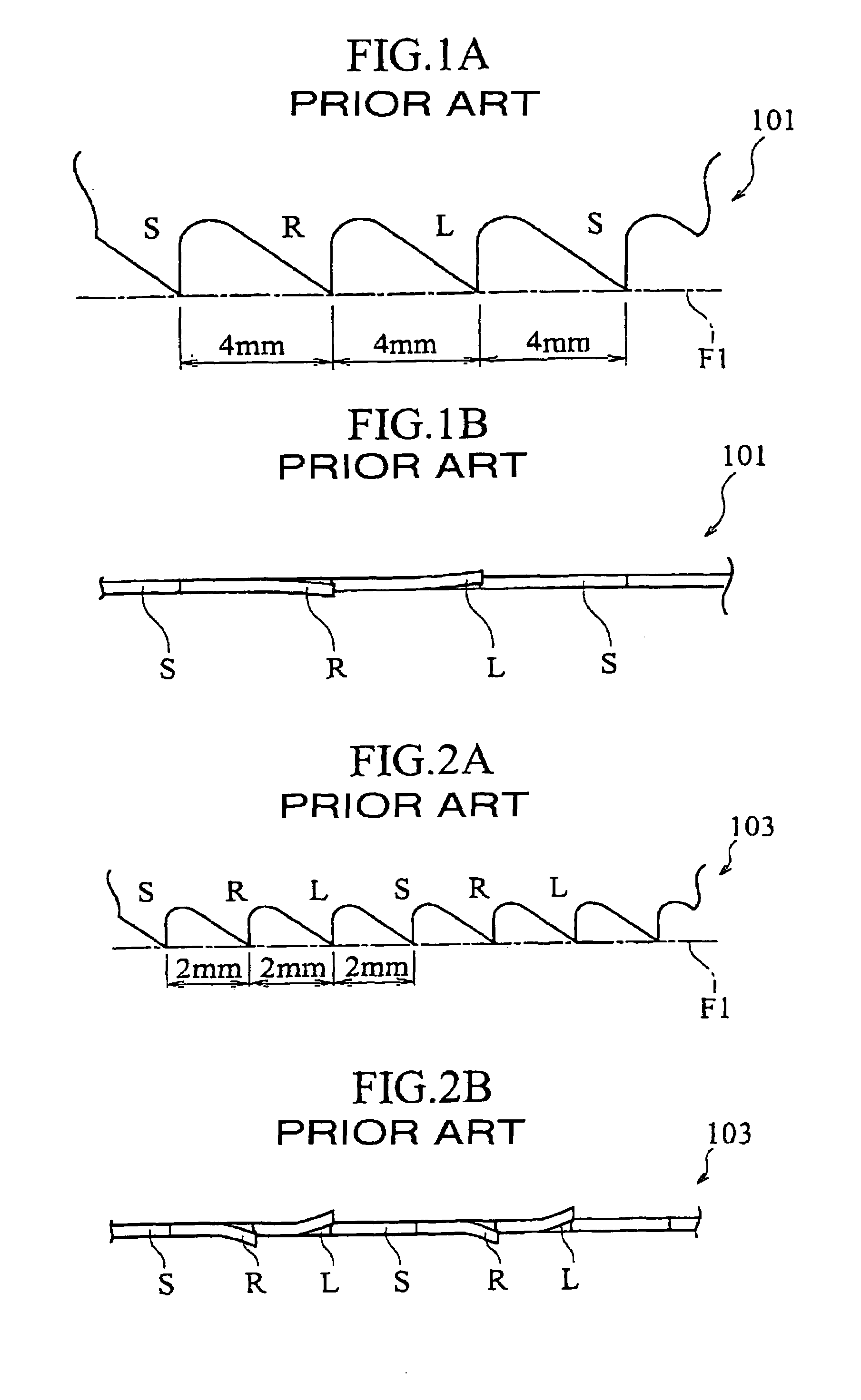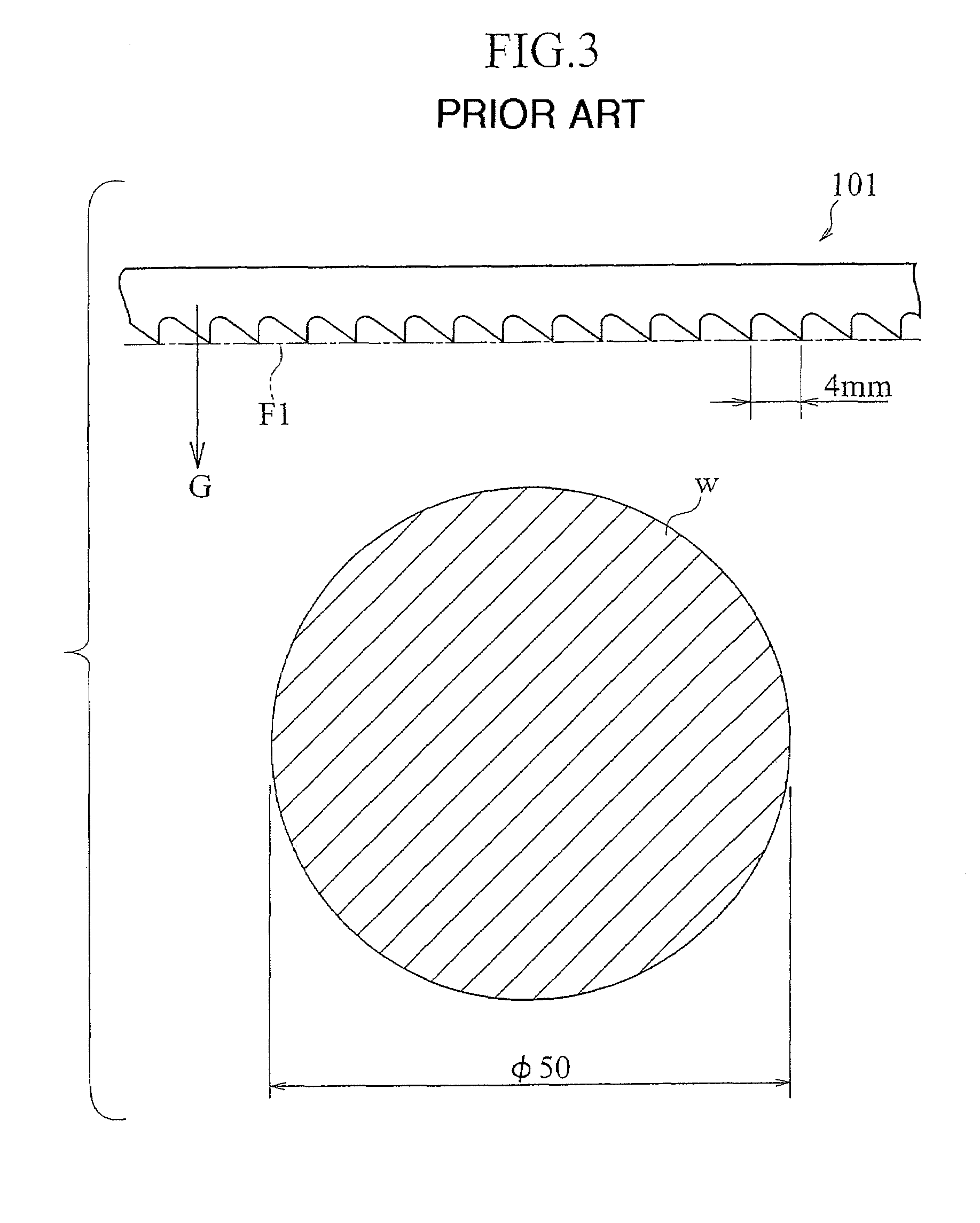Saw blade
a technology of saw blades and blades, applied in the field of saw blades, can solve the problems of prone to breakage, excessive cutting, and easy to break teeth, and achieve the effect of easy cutting a solid material and a pipe material
- Summary
- Abstract
- Description
- Claims
- Application Information
AI Technical Summary
Benefits of technology
Problems solved by technology
Method used
Image
Examples
first embodiment
[0072]Referring to FIGS. 6A and 6B, in a saw blade 1 according to the present invention, a set pattern of a combination of a first teeth group (saw teeth belonging to the first teeth group are shown with symbols A) and a second teeth group (saw teeth belonging to the second teeth group are shown with symbols B) is repeated appropriately. The first teeth group has a spur tooth S which is not bent in the lateral direction (thickness direction of the saw blade 1) with respect to the saw blade 1 and a pair of left and right set teeth Lw and Rw having a relatively large set amount in the lateral direction (i.e., set width is wide). The second teeth group has a pair of left and right set teeth Ln and Rn having a set amount (i.e., set width is narrow) smaller than the set amount of the left and right set teeth Lw and Rw of the first teeth group A.
[0073]The saw blade 1 run from left to right in the drawings to cut a workpiece. In this case, in the cutting operation, the teeth Lw, Ln, Rw, Rn...
second embodiment
[0082]FIGS. 7A and 7B show a saw blade 3 of the invention. In the saw blade 3, there is a height difference H1 between saw teeth corresponding to the first teeth group A and saw teeth corresponding to the second teeth group B, and distances between the saw teeth are equal pitches P1.
[0083]In other words, the tips of the spur teeth S, Lw and Rw are arranged such as to coincide with a first phantom line F1 shown with chain line. On the other hand, the tips of the saw teeth St, Ln and Rn are arranged such as to coincide with a second phantom line F2 shown with chain line. A height difference between the first phantom line F1 and the second phantom line F2 corresponds to the height difference H1 of the tooth height of the saw teeth.
[0084]Since there is the height difference H1 between the tips of the set teeth S, Lw and Rw and the tips of the saw teeth St, Ln and Rn, depths of garrets thereof are different. That is, the set teeth Ln and Rn belonging to the second teeth group B have low ...
fifth embodiment
[0106]In the saw blade 9 of the fifth embodiment, the arrangement of the left and right set teeth Lw and Rw of the first teeth group A and the left and right set teeth Ln and Rn of the second teeth group B can appropriately be changed. In this case, the left and right set teeth Lw and Rw of the first teeth group A and the left and right set teeth Ln and Rn of the second teeth group B are arranged such that the teeth set in the same direction are not continuously arranged.
[0107]Referring to FIGS. 11A and 11B, in a saw blade 11 of a sixth embodiment of the invention, left and right set teeth Ln2 and Rn2 having low tooth height and small set amount are added to the second teeth group B of the saw blade 5 of the third embodiment shown in FIGS. 8A and 8B, and the number of saw teeth is increased, and the pitches P1 between the saw teeth are equal to each other.
[0108]More specifically, the first teeth group A comprises a total of three teeth, i.e., one spur tooth S having high tooth heigh...
PUM
| Property | Measurement | Unit |
|---|---|---|
| Height | aaaaa | aaaaa |
| Height | aaaaa | aaaaa |
Abstract
Description
Claims
Application Information
 Login to View More
Login to View More - R&D
- Intellectual Property
- Life Sciences
- Materials
- Tech Scout
- Unparalleled Data Quality
- Higher Quality Content
- 60% Fewer Hallucinations
Browse by: Latest US Patents, China's latest patents, Technical Efficacy Thesaurus, Application Domain, Technology Topic, Popular Technical Reports.
© 2025 PatSnap. All rights reserved.Legal|Privacy policy|Modern Slavery Act Transparency Statement|Sitemap|About US| Contact US: help@patsnap.com



